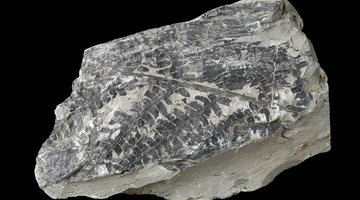Ferns come in a variety of shapes and sizes and this interactive explores the diversity of form in New Zealand ferns.
The fern body consists of 3 major parts – the rhizome, the fronds and the sporangia. This interactive explores the sporangia – click on the labels for more information.
Find out more about the upper layer of ferns in this related interactive.
Select here to view the full transcript and copyright information.

Ferns come in a variety of shapes and sizes. Use this interactive to explore the diversity of form in New Zealand ferns.
The fern body consists of 3 major parts – the rhizome, the fronds and the sporangia. This interactive explores the sporangia – click on the labels for more information.
Find out more about the upper layer of ferns in this related interactive.
Transcript
Frond dissection
Fronds can be simple and undivided like the leather leaf fern, or pinnate (once divided) like the thread fern. More commonly, fronds are bipinnate (silver fern) or tripinnate (hen and chickens fern).
Image acknowledgements: University of Waikato, Steve Attwood, Public domain and Museum of New Zealand Te Papa Tongarewa
Sori position
The sori may be located on the edge of the pinna or away from the pinna margin.
Image acknowledgement: Museum of New Zealand Te Papa Tongarewa
Sorus
Each sorus is a cluster of sporangia. The shape and position of the sori are important for identification of ferns. They provide the main features for identifying the different genera. Sori can be round, oval, oblong or considerably elongated. They may occur on the edge of the pinna or away from the edge. With a 10x hand lens, you’ll be able to see that the sori are composed of numerous, small, round bodies that are the sporangia.
Image acknowledgement: Museum of New Zealand Te Papa Tongarewa
Indusium
A flap of tissue that protects the sori in some ferns. This can take a variety of forms. When spores are mature and ready for release, the indusia usually shrivel or bend backwards to expose the sporangia. Occasionally, if the indusia completely cover the sporangia. they may tear irregularly.
Image acknowledgement: Museum of New Zealand Te Papa Tongarewa
Sporangium
The reproductive structures on the underside of the frond. Each sporangium is a capsule that contains spores. They are usually aggregated into clusters called sori. The position and arrangement of the sporangia are very important for the identification of ferns. Fronds that have sporangia on their underside are fertile, and those that don't are sterile.
Image acknowledgement: Museum of New Zealand Te Papa Tongarewa
Spore
A single cell. Spores are produced in capsules called sporangia. Most ferns produce 64 spores in each sporangium. Sporangia are aggregated into clusters called sori. When mature, the spores are released from the sporangia. Once released, the spores germinate readily on contact with damp soil.
Image acknowledgement: Australasian Pollen and Spore Atlas, Creative Commons


